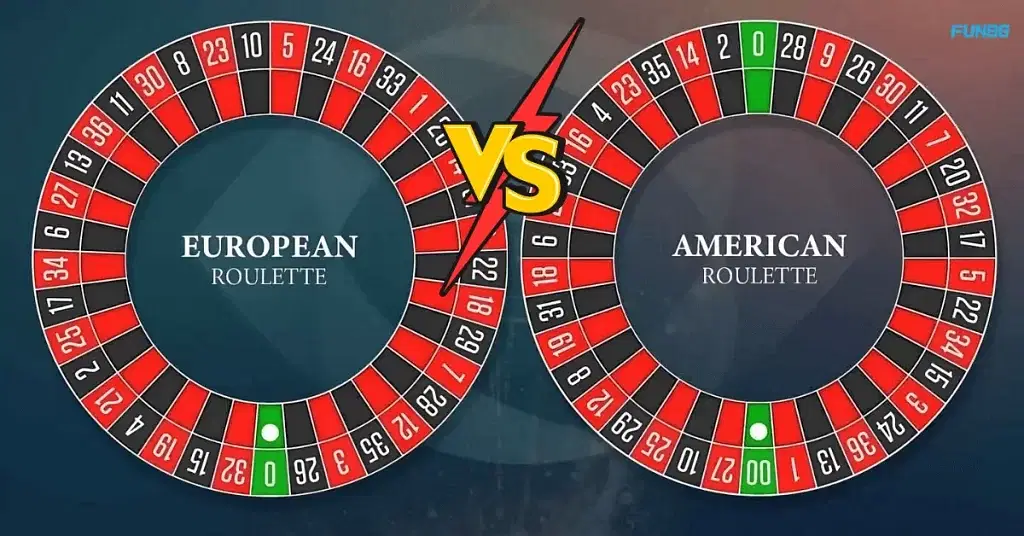Roulette is one of those classic games that immediately conjures images of glamour and excitement. Picture this: a glitzy casino floor, the soft whirring sound of the spinning wheel, and the quiet anticipation as the little white ball determines your fate.
But before you step up to the table, there’s an essential decision to make between European Roulette vs American Roulette. Each version has its unique features, strategies, and, of course, odds. Let’s delve into what makes them distinct and, more importantly, how they might impact your gaming experience.
The Basics of the Wheel
Roulette, named after the French word meaning “little wheel,” comes in several variants, but the two most popular are American and European. Understanding the fundamental differences between the wheels is crucial because they impact almost every other facet of the game – especially your odds.
European Roulette vs American Roulette: The Basic Difference
American Roulette
American Roulette is characterised by its 38 pockets. It includes numbers 1 through 36, a single zero (0), and a double zero (00). The additional double zero is the main differentiator. At first glance, this might seem like a minor detail—after all, it’s just one extra pocket, right? But this seemingly small difference has a sizable impact on your odds.
European Roulette
Contrarily, European Roulette features a wheel with 37 pockets—numbers 1 to 36 and a single zero. No double zero here means a slimmer lineup of pockets. Less complexity usually means better odds for the player, but we’ll dive deeper into that a bit later.
Cultural and Historical Context
Roulette has a rich history dating back to 18th-century France, evolving into various forms as it spread globally. Understanding the cultural and historical context can enhance one’s appreciation of each version.
American Roulette
Introduced in the United States in the 19th century, American Roulette adapted to its environment by adding the double zero—a move designed to increase house profits, appealing to the growing U.S. wagering industry of the time. It retains its popularity in American casinos and has become synonymous with the U.S. gaming culture.
European Roulette
Classic and timeless, European Roulette preserves closer ties to the original French version. The single zero format and potential player-friendly rules often symbolise sophistication and strategy-centric gaming, favoured across Europe and other regions alike.
Related Read: Basic Game Rules for American Roulette: Key Features, Bets Type
Online Roulette: A Modern Twist
In the digital age, both American and European Roulette have found new life online. Online casinos offer opportunities to experience both variants without geographical limitations, providing additional layers like live dealer games and bonuses.
Accessibility and Convenience
Whether you prefer desktops or mobile devices, online platforms like Fun88 allow you to play either Roulette version. The advancement in technology offers high-definition graphics and interactive interfaces, replicating the feel of traditional gaming from the comfort of your home.
Strategies for Online Play
Online platforms often introduce features such as practice modes and bonuses, making them ideal for trying out strategies without risking actual money. Players can experiment with different wagering systems, such as Martingale or Fibonacci, especially when playing European versions that offer better odds.
How Do They Differ in Odds?
Understanding the odds can feel daunting, but knowing the Basic Roulette Game Rules is a must when it comes to Roulette. The house edge—a casino’s built-in advantage—varies between these two versions and can influence your choice.
House Edge in American Roulette
In American Roulette, the house edge is about 5.26%. This means that for every $100 you wager, you could statistically expect to lose $5.26 over time. The double zero adds that extra bit of house advantage, shifting the odds more in favour of the casino.
House Edge in European Roulette
On the European side, the house edge is approximately 2.70%. That’s almost half of its American counterpart. The absence of the double zero accounts for this lower edge, making it a more player-friendly game. As a savvy wagerer, maximising your potential winnings often means minimizing the house’s cut.
Wagering Options: More Than Meets the Eye
Both American and European Roulette offer an array of wagering options, most of which are similar across both formats. Yet, subtle differences can still be seen. Your ability to understand these options can shape how you approach the game and strategize for success.
Types of Bets
- Inside Bets: Both versions offer inside bets—bets placed on individual numbers or small groups of numbers. These bets include straight bets, splits, streets, corners, and lines. Generally, these are riskier but come with higher potential payouts.
- Outside Bets: Always available, outside bets cover larger segments of the wheel such as red or black, even or odd numbers, and high or low. These are considered safer, but the payouts are smaller.
- Five-Number Bet: Unique to American Roulette, this controversial bet covers 0, 00, 1, 2, and 3. However, with its whopping 7.89% house edge, many players avoid this bet altogether.
Racetrack and Special Bets
In some European roulette tables, especially in high-end casinos or online platforms, you may find a “racetrack” layout, where special bets like “Neighbors of Zero,” “Tiers du Cylindre,” and “Orphelins” are available. These bets cover specific sections of the wheel and can add an extra layer of strategy to how you play. American tables generally don’t offer these specialised bets.
Roulette Game Rules: Are They Really That Different?
Both versions follow the same Roulette game rules and mechanics. You place bets, the wheel spins, the ball lands, and then wins and losses are declared. However, there are some nuances—specifically in European Roulette, that players appreciate.
En Prison and La Partage
Unique to European Roulette, these rules can benefit players under certain conditions.
- En Prison: If you place an even-money bet and the ball lands on zero, you can opt to leave your bet “en prison,” or “in prison,” for the next spin. If your bet wins on the next spin, you retrieve your initial stake without additional winnings.
- La Partage: This is similar to En Prison but slightly different. If an even-money bet lands on zero, you instantly retrieve half your stake. Consequently, the house edge on even-money bets reduces further due to these rules, making them particularly attractive.
Absence of Advanced Rules in American Roulette
American Roulette does not offer En Prison and La Partage, sticking to its straightforward format. This absence often makes European Roulette a more favourable option for players seeking a lower house edge and more player-centric rules.
Strategic Approach: What to Consider?
Your strategic preferences could influence your decision to play American or European Roulette. Some players lean towards specific versions based on how these strategies align with their gameplay style.
Risk versus Reward
- American Roulette: The double zero increases the risk factor, which can appeal to players seeking adrenaline and higher stakes. American tables might capture your attention more if the aim is quick thrills and instant gratification.
- European Roulette: Offering better odds and special rules for even-money bets, European Roulette can be more suited to players who appreciate strategy, statistical advantage, and measured risks.
Bankroll Management
When it comes to bankroll management, European Roulette generally provides more sustainable play options. With a lower house edge and potential special rules, your stack might last longer, allowing more rounds and, hopefully, more winning chances.
Also Read : How To Play European Roulette Like a Pro: The Ultimate Guide
Conclusion
Choosing between American and European Roulette boils down to personal preference, but now you’re equipped with the insights to make an informed decision. Whether you select the ideal single-zero play of European Roulette or the classic double-zero style introduced by American Roulette, there’s a world of strategy, fun, and experience to explore.
Ultimately, each version has its own charm and appeal, shaped by history, culture, and house rules. That thrill of the spin and the opportunity to win big remains universal, irrespective of the version you choose. So, armed with knowledge and a bit of luck, it’s time to place your bets and enjoy the game.
FAQs About American Vs European Roulette
‘En Prison’ allows players to recover their even-money bets if the ball lands on zero by holding the bet over for the next spin. ‘La Partage’ returns half of an even-money bet to the player if the spin results in zero. These rules further reduce the house edge on even-money bets in European Roulette.
The additional double zero on the American wheel increases the house advantage, meaning fewer favourable odds for players. Higher house advantage translates to a higher risk when placing bets.
European Roulette is generally more popular globally due to its lower house edge, which entices players. However, American Roulette often dominates U.S. casinos, following traditional preferences and offering unique wagering options.
Yes, online platforms often provide practice or demo modes, allowing players to try out American and European Roulette strategies without any financial risk. This helps them understand the differences and hone their skills.
Star it if you find it helpful.

